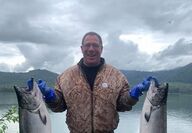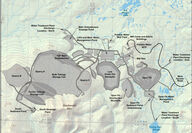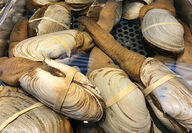Sorted by date Results 76 - 100 of 464
Snacks that are good for people and the planet now come in the form of crispy chips that are made from Bristol Bay sockeye salmon skins. The new, flash fried snack was spawned by a Los Angeles-based company called Goodfish, which aims to “propel sustainable seafood into our mass-market consumer culture.” It is the second venture for partners Justin Guilbert and Douglas Riboud, a well-financed duo who are committed to trailblazing brands that have “higher standards of sourcing, manufacturing, and social ethos.” A decade ago they co-foun...

It was inaction on health care that ultimately made Dr. Al Gross of Juneau decide to challenge Republican Dan Sullivan, who is running for a second, six-year term to represent Alaska in the U.S. Senate. Gross, who has opted for the Independent ticket, has fished his whole life, his four kids have fished to pay for college, and he left a 20 year career as an orthopedic surgeon to get a degree to go to work in public health. His campaign claims Dr. Gross has the "Prescription for Change." "As a...
Unless you fished for salmon this summer at Bristol Bay, it’s been slim pickings for fishermen in other Alaska regions. Salmon returns have been so poor that communities already are claiming fishery disasters. Cordova’s City Council last week unanimously passed a resolution asking the state to declare disasters for both the 2018 Copper River sockeye and Chinook salmon runs and the 2020 sockeye, chum and Chinook runs at the Copper River and Prince William Sound. The resolution also urges the state and federal governments to declare a “condition...
It got little attention from the mainstream media but seafood netted some historic firsts in the nation’s new dietary guidelines. The Dietary Guidelines Advisory Committee submitted a report in July to the Secretaries of Agriculture and Health and Human Services that recommends what Americans should include in their diets from 2020 through 2025, a task it has undertaken every five years since 1980. “This is by far the strongest they’ve come out for seafood in all of the U.S. dietary guidelines history, and at virtually every point in the lifecy...
Alaska’s seafood industry stakeholders have a four bagger chance to provide input on policy decisions that directly affect their livelihoods: trade, relief payouts for cod and salmon, Board of Fisheries meeting plans and appointees. For several, the window of opportunity is tight. Here is the line-up according to the deadline dates for comments: 1. Trade input - By August 1 suggestions are invited for a newly-established seafood trade task force to be chaired by the U.S. Trade Representative and the Dept. of Commerce. The chance to provide i...
Most Alaskans are surprised to learn that seafood is by far Alaska’s top export, the source of the state’s largest manufacturing base and its #1 private employer. More surprising is that those simple to find facts are not included in the official trade sheet for Alaska provided by the office of the U.S. Trade Representative (USTR). The information on the USTR website, for example, incorrectly claims that petroleum and coal were Alaska’s top exports in 2018. But seafood has been state’s top export by far for decades. “Seafood comprises...
Governor Dunleavy’s controversial selections to the state Board of Fisheries (BOF) will get a legislative hearing in early fall and the call is out for public comments. The board oversees management of the state’s subsistence, commercial, sport and personal use fisheries. Appointments were made on April 1 and would normally go through a vigorous vetting process by the Alaska legislature with public input. But COVID-19 sent lawmakers home early from the last session, leaving the confirmation process in limbo. Now, Representative Louise Stutes (R...
The global seafood industry will experience lasting impacts from the COVID-19 pandemic, including reduced demand and pricing. That is the conclusion of the State of World Fisheries and Aquaculture report produced every two years by the Food and Agriculture Organization (FAO) of the United Nations, the only report that tracks global fisheries and food trends. This year it included a special focus on the pandemic which has toppled seafood markets and supply chains around the world. The report forecasts that global seafood production will be down...

The biggest red salmon run in the world is building at Bristol Bay. Up to 50 million fish could surge into its eight river systems in coming weeks, on par with past seasons. When it's all done, the fishery will provide nearly half the global supply of wild sockeye salmon. But this summer is different. Not only due to the restrictions and fears and economic chaos caused by Covid-19. At the height of the fishery, fishermen will learn if a massive gold and copper mine that's been hanging over...
Unexpected upheavals stemming from the coronavirus have slowed the process of getting relief payments into the hands of fishermen and communities hurt by the 2018 Gulf of Alaska cod crash. In late February, the Secretary of Commerce cut loose $24,416,440 for affected stakeholders. Then in late March, Alaska Dept. of Fish and Game Commissioner Doug Vincent-Lang proposed a written timeline for developing a distribution plan and also called for input from communities and fishing groups. A draft of the initial plan was intended to compile...
All systems are go for keeping close tabs on fish and crab stocks in waters managed by the state, meaning out to three miles. While constraints from the coronavirus resulted in nearly all annual stock surveys being cut in deeper waters overseen by the federal government, it’s “closer to normal” closer to shore. “While it’s not business as usual, we are conducting business in as close to normal fashion as we can,” said Forrest Bowers, deputy director of the commercial fisheries division of the Alaska Dept. of Fish and Game. “We have kept all...

Surveys of Alaska's fish, crab and halibut stocks in the Bering Sea have been called off or reduced due to constraints and dangers posed by the coronavirus. In what they called an "unprecedented" move, NOAA Fisheries announced in late May that five Alaska surveys will be cancelled this summer "due to the uncertainties created by the COVID-19 pandemic, and the unique challenges those are creating for the agency." NOAA said in a statement that they found "no way to move forward with a survey plan...
Recycled fishing nets from Cordova will soon help launch a new clothing line by Grundens, the maker of the iconic foul weather gear “built by fishermen for fishermen for over a century.” The Copper River Watershed Project is “refreshing” its net recycling program underway for a decade that’s been backed by the Pacific Marine States Commission. Now, the program wants to broaden its base and stand on its own, said Shae Bowman, Watershed operations manager. “The vision with a new program is to create a self-sustaining recycling program tha...
A rapid response by nearly 800 Alaska fishermen will provide a guideline for giving them a hand up as the coronavirus swamps their operations. An online survey from April 14-May 3 by Juneau-based nonprofit SalmonState asked fishermen about their primary concerns both before the Covid outbreak and in the midst of the pandemic in April. It also asked what elected officials at local, state and federal levels can do to help them directly. Over half of the 817 responses came in over four days, said Tyson Fick, Salmon State communications ad...
Giving COVID relief funds to the seafood industry and stepping on the gas for offshore fish farming are two big takeaways from the executive orders and congressional packages coming out of the nation’s capital. Recent news that Alaska would receive $50 million from the $300 million fisheries relief funds in the Coronavirus Aid, Relief, and Economic Security (CARES) Act was well received by industry stakeholders and it’s likely to be followed by more. A May 15 hearing called “COVID 19 impacts to American Fisheries and the Seafood Supply Chain...
Sales of Alaska’s most popular seafoods are being hit hard by markets upended by the coronavirus, but perhaps none is getting battered worse than halibut. Along with the big losses in the lucrative restaurant trade, Pacific halibut also is facing headwinds from increasing foreign imports. Starting three years ago, sales of fresh Pacific halibut to established markets on the east coast were toppled by a flood of less expensive fish flowing in primarily from eastern Canada. Trade data show that for 2019 through February 2020, total Canadian h...
The value of Alaska salmon permits is another casualty of the coronavirus with prices dropping for all fisheries across the state. There are a lot of permits for sale - and the most offers ever to lease permits, especially at Bristol Bay. The virus has changed everything, said Doug Bowen of Alaska Boats and Permits in Homer. “There’s so much uncertainty about if there will even be a salmon season here and there, and if so, what kind of a price can be expected and so on. I can’t think of one salmon permit that is going up in value. And if there...
Strict new rules are now in place for Alaska fishermen and their vessels to protect against and prevent the spread of COVID-19 during the 2020 salmon season. Effective April 24, Governor Dunleavy provided 11 pages of mandates that specifically apply to those who have not “agreed to operate under a fleet-wide plan submitted by a company, association or entity” representing them. Among other things, each independent skipper must sign a “Health Mandate Acknowledgement Form” prior to going fishing. They are required to maintain a written or time...
How can fishermen be sure their vessels are clean of coronavirus contamination? Where can they find out about relief funds that are newly available for fishermen? COVID-19 has Alaska’s seafood industry traveling in uncharted waters as more fisheries continue and get underway, and fishermen and processors prepare for a salmon season that’s just a month away. Information in an upside down world changes daily, making it tough to plot a course. United Fishermen of Alaska has crafted a “one stop shop” for the latest fishing-related COVID-19 updates...
The State of Alaska wants input on plans to distribute nearly $24.5 million in federal disaster relief funds for stakeholders and communities hurt by the 2018 Gulf of Alaska cod crash. Better make it quick – the deadline to comment is April 10. Cod is Alaska’s second largest groundfish harvest (after pollock), but the Gulf stock dropped by 80% in 2018 following a three year heatwave that disrupted food webs, fish metabolism and egg survival on the ocean floor. It combined to push down cod catches to just 28.8 million pounds, compared to nea...
The U.S. seafood industry received a $300 million assist from the $2 trillion COVID-19 relief package passed by Congress on March 27, and a wide coalition of industry stakeholders is hoping for more. Fishery recipients in the relief bill include tribes, persons, communities, processors, aquaculture and other related businesses. SeafoodNews.com reports that those eligible for relief must have “revenue losses greater than 35 percent as compared to the prior 5-year average revenue, or any negative impacts to subsistence, cultural, or ceremonial f...
The Pacific halibut fishery opened on March 14 amid little fanfare and flattened markets. The first fish of the eight month season typically attracts the highest prices and is rushed fresh to high-end buyers, especially during the Lenten season. But that’s not the case in this time of coronavirus chaos, when air traffic is stalled and seafood of all kinds is getting backlogged in global freezers. Alaska’s share of the 2020 halibut catch is about 17 million pounds for nearly 2,000 fishermen who own shares of the popular flatfish. A week int...

Alaska shellfish farmers and divers fear they won't be 'open for business' much longer if they're forced to pick up the tab for federally required lab tests as outlined in Governor Dunleavy's budget. The Department of Environmental Conservation (DEC) has proposed shifting the state cost to the harvesters which last year totaled almost a half million dollars. Geoduck clam divers in Southeast Alaska, for example, pay about $150,000 each year to collect samples that are sent to the single...
Seafood coming from and going to China is piling up in freezer vans and cold storages indefinitely as the coronavirus continues to cause commerce chaos around the world. About 80% of trade of the world’s goods by volume is carried by sea and China is home to seven of the world’s 10 busiest container ports, according to the United Nations Conference on Trade and Development. Virus precautions mean that many ships can’t get into Chinese ports, others are stuck at docks waiting for workers to return, and still more are idling in “floating quarant...
Dutch Harbor remained the top fishing port in the USA for the 22nd year in a row with 763 million pounds crossing the docks in 2018 valued at $182 million. And Naknek ranked as the nation’s second most valuable port for fishermen with landings worth $195 million. (Naknek also ranked #8 for landings at $191 million.) Empire-Venice, Louisiana held the second spot for fish volume (569 million). The “Aleutians” was close behind (539 million), thanks to Trident’s plant at Akutan, the largest processing facility in North America. Kodiak fell to four...